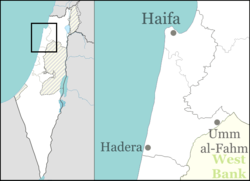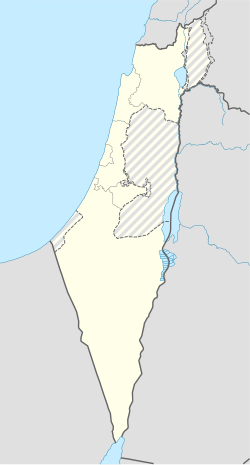Fureidis (also Freidis; Arabic: فريديس, Hebrew: פֻרֵידִיס) is an Arab town in the Haifa District of Israel. It received local council status in 1952. In 2022 its population was 13,722.[1]
Fureidis
| |
|---|---|
| Hebrew transcription(s) | |
| • ISO 259 | P̄ureidis |
 Fureidis | |
| Coordinates: 32°35′48″N 34°57′02″E / 32.59667°N 34.95056°E | |
| Grid position | 145/222 PAL |
| Country | Israel |
| District | |
| Area | |
| • Total | 2,690 dunams (2.69 km2 or 1.04 sq mi) |
| Population (2022)[1] | |
| • Total | 13,722 |
| • Density | 5,100/km2 (13,000/sq mi) |
| Name meaning | "The little Paradise"[2] |
Name
editThe name is believed to come from the Arabic (firdawis), meaning little Garden of Eden, borrowed from the Persian word for paradise.[2][3]
History
editA cave above the old part of Fureidis on the western slope of the Carmel was found to contain fragments of pottery from the Chalcolithic period, including large bowls, jars, ossuary fragments and a pale pink limestone pendant. It appears to have been used as a dwelling and a burial cave. The artifacts in the cave attest to the presence of a settlement from the pre-Ghassulian period.[4]
Pottery and remains from an aqueduct dating to the Roman and Byzantine periods have also been found.[5]
In the 19th century, three rock-hewn tombs were examined at Fureidis, each with several kokhim.[6]
At the northern edge of Fureidis, pottery remains from the 13th -14th century, a coin dating to 1388–1399 CE, and building remains dated to the Mamluk period have been excavated.[7]
Ottoman era
editIn 1517 Fureidis was incorporated into the Ottoman Empire with the rest of Palestine. During the 16th and 17th centuries, it belonged to the Turabay Emirate (1517-1683), which encompassed the Jezreel Valley, Mount Carmel, Beit She'an Valley, northern Samaria, Ramot Menashe, the northern part of the Sharon plain.[8]
During the late Ottoman period, in 1859, the English consul Rogers estimated the population to be 200, who cultivated 18 feddans of land.[9]
In 1870, the French explorer Victor Guérin visited the village. He estimated it had one hundred and forty people, mostly shepherds and woodcutters, some who also cultivated the land.[10]
In 1882, the PEF's Survey of Western Palestine (SWP) described the place as a village of adobe and stone at the foot of the hill, with a well to the south.[9]
A population list from about 1887 showed that Kh. Fureidis had about 300 inhabitants, all Muslim.[11]
British Mandate era
editIn the 1922 census of Palestine conducted by the British Mandate authorities, Al Feridis had a population of 335; all Muslims,[12] increasing in the 1931 census to 454; still all Muslims, in a total of 98 houses.[13]
In the 1945 statistics the population of Fureidis consisted of 780 Muslims[14] and the land area was 4,450 dunams, according to an official land and population survey.[15] Of this, 365 dunams were designated for plantations and irrigable land, 1,717 for cereals,[16] while 6 dunams were built-up (urban) areas.[17]
1948 war and after
editFureidis is one of the few Arab villages on Israel's coast left intact after the 1948 war.[3] During the conflict, it received a great number of refugees from nearby villages, including Tantura, and was repeatedly considered for assault by Israeli forces.[citation needed] However, residents of local Jewish settlements, in particular Zichron Yaakov requested that Fureidis (and the neighbouring village of Jisr az-Zarqa) be allowed to remain, as they had traditionally had good relations with the Yishuv, and a large number of residents from Fureidis worked as hired labour on Jewish farms.[citation needed] This was alluded to by Arab novelist Emile Habibi in his famous novel The Secret Life of Saeed the Pessoptimist.[18]
As of the census of 2008, Fureidis had 10,800 residents, of whom 99.6% were Muslim Arabs.[19]
According to data released by the Israeli Ministry of Education based on a 2008 census of high school matriculation scores, Fureidis had a 75.85% eligibility rate, greatly exceeding the accomplishments of most Jewish towns. The national eligibility rate in 2008-2009 was 44.4 percent of all 17-year-olds. Fureidis won third place in the national ranking. Hossni Abu Dahash, the town's high school principal, said the school had organized a marathon study program to prepare 12th graders for their matriculation exam.[20]
Ibtisam Mahmid, whose family came from Tantura, became an activist after 1995 when she was thrown out of an Egged bus because she was an Arab.[21]
Ibtisam Mahammed of Fureidis was awarded the Dalai Lama's Unsung Heroes of Compassion prize for her efforts to promote peace between Arabs and Jews.[22] For many years Mahammed has been organizing Jewish and Arab women's circles to promote dialogue. She heads several women's peace organizations and has fought on behalf of battered women in Arab society.[22]
Folklore
editIn the center of Fureidis, there is a tomb-shrine called ash-Sheikh Ghneim, said to contain the grave of a Sufi sheikh from Benha, Egypt. His only son, Mer'i, is the ancestor of the prominent local clan bearing his name. Historically, villagers lit candles at the tomb on Fridays.[23]
Notable people
edit- Mohamed Abu Arisha (born 1997), Israeli-Arab basketball player for Hapoel Be'er Sheva of the Israeli Basketball Premier League and the Israeli national basketball team
- Ibtisam Mara'ana, Israeli-Arab politician and film director
See also
editReferences
edit- ^ a b "Regional Statistics". Israel Central Bureau of Statistics. Retrieved 21 March 2024.
- ^ a b Palmer, 1881, p. 146
- ^ a b Another Paradise Casts Out a Feisty Woman, Talya Halkin for The Forward, 2003.
- ^ Yannai, 2007, El-Fureidis
- ^ Spivak, 2008, El-Fureidis Region, Survey
- ^ Conder and Kitchener, 1882, SWP II, pp. 52-53, noting that the 3rd grave was very similar to the one at Kh. Ibreitas, see Conder and Kitchener, 1882, SWP II, p. 31
- ^ Torge, 2011, Horbat Tawwasim
- ^ Marom, Roy; Tepper, Yotam; Adams, Matthew (2023). "Lajjun: Forgotten Provincial Capital in Ottoman Palestine". Levant. 55 (2): 218–241. doi:10.1080/00758914.2023.2202484. S2CID 258602184.
- ^ a b Conder and Kitchener, 1882, SWP II, p. 41
- ^ Guérin, 1875, p. 305
- ^ Schumacher, 1888, p. 181
- ^ Barron, 1923, Table XI, Sub-district of Haifa, p. 34
- ^ Mills, 1932, p. 90
- ^ Department of Statistics, 1945, p. 13
- ^ Government of Palestine, Department of Statistics. Village Statistics, April, 1945. Quoted in Hadawi, 1970, p. 47
- ^ Government of Palestine, Department of Statistics. Village Statistics, April, 1945. Quoted in Hadawi, 1970, p. 90
- ^ Government of Palestine, Department of Statistics. Village Statistics, April, 1945. Quoted in Hadawi, 1970, p. 140
- ^ Habibi, Emile, The Secret Life of Saeed the Pessoptimist, Arabia Books, London, 2010 ( Chapter 24)
- ^ "Population Profile Fureidis" (PDF). Central Bureau of Statistics, Israel. Archived from the original (PDF) on 4 May 2014. Retrieved 28 January 2013.
- ^ Matriculation gap widens, Or Kashti, Aug. 11, 2009, Haaretz
- ^ Fureidis bus boycott Archived 2008-08-01 at the Wayback Machine, Ariel Rubinsky, June 17, 2008, Haaretz
- ^ a b Israel's unsung female heroes By Ofri Ilani, Jun. 8, 2009, Haaretz
- ^ Tal, Uri (2023). Muslim Shrines in Eretz Israel: History, Religion, Traditions, Folklore (in Hebrew). Jerusalem: Yad Izhak Ben-Zvi. p. 97. ISBN 978-965-217-452-9.
Bibliography
edit- Barron, J.B., ed. (1923). Palestine: Report and General Abstracts of the Census of 1922. Government of Palestine.
- Conder, C.R.; Kitchener, H.H. (1882). The Survey of Western Palestine: Memoirs of the Topography, Orography, Hydrography, and Archaeology. Vol. 2. London: Committee of the Palestine Exploration Fund.
- Department of Statistics (1945). Village Statistics, April, 1945. Government of Palestine.
- Guérin, V. (1875). Description Géographique Historique et Archéologique de la Palestine (in French). Vol. 2: Samarie, pt. 2. Paris: L'Imprimerie Nationale.
- Hadawi, S. (1970). Village Statistics of 1945: A Classification of Land and Area ownership in Palestine. Palestine Liberation Organization Research Center.
- Mills, E., ed. (1932). Census of Palestine 1931. Population of Villages, Towns and Administrative Areas. Jerusalem: Government of Palestine.
- Morris, B. (1994). "8". 1948 and after; Israel and the Palestinians. Oxford University Press. pp. Ghosh and Beit Naqquba, Al Fureidis and Jisr Zarka. ISBN 0-19-827929-9.
- Oren, Eliran (2010-02-02). "Horbat Tafat" (122). Hadashot Arkheologiyot – Excavations and Surveys in Israel.
{{cite journal}}: Cite journal requires|journal=(help) - Palmer, E.H. (1881). The Survey of Western Palestine: Arabic and English Name Lists Collected During the Survey by Lieutenants Conder and Kitchener, R. E. Transliterated and Explained by E.H. Palmer. Committee of the Palestine Exploration Fund.
- Schumacher, G. (1888). "Population list of the Liwa of Akka". Quarterly Statement - Palestine Exploration Fund. 20: 169–191.
- Spivak, Polina (2008-05-29). "El-Fureidis Region, Survey" (120). Hadashot Arkheologiyot – Excavations and Surveys in Israel.
{{cite journal}}: Cite journal requires|journal=(help) - Torge, Hagit (2011-10-23). "Horbat Tawwasim" (123). Hadashot Arkheologiyot – Excavations and Surveys in Israel.
{{cite journal}}: Cite journal requires|journal=(help) - Yannai, Eli (2007-04-18). "El-Fureidis" (119). Hadashot Arkheologiyot – Excavations and Surveys in Israel.
{{cite journal}}: Cite journal requires|journal=(help)
External links
edit- Welcome To Fureidis
- Survey of Western Palestine, Map 8: IAA, Wikimedia commons
- Fureidis, Paradise Lost, a documentary by Ebtisam Mara’ana

